Growing cucumbers is and will remain a perennial favorite among home gardeners. You can find tips for growing, caring for and harvesting cucumbers here.
The cultivation of cucumbers (Cucumis sativus) is not particularly difficult in your own garden. With the right cultivation and care, the needs of the whole family can be easily covered over the summer. In the warm season, the green fruit is refreshing with its high water content. For the winter you can Pickle cucumber and can therefore be kept for months. The healthy cucumber vegetable originally comes from India and has been known in Europe for centuries. Despite its exotic origin, the cucumber also thrives in cooler temperatures in this country. We have summarized for you what needs to be considered for the successful cultivation of cucumbers.
contents
-
plant cucumbers
- The right location
-
Cucumber varieties: something for everyone
- cucumbers
- pickled cucumbers
- peeled cucumbers
-
plant cucumbers
- As no-till
- As a preculture
-
Cucumber growing care
- Water cucumbers properly
- Fertilize cucumbers properly
- Diseases and pests in cucumbers
-
Harvesting and storing cucumbers
- Harvest cucumbers properly
- Store cucumbers properly
- Pickle cucumbers
plant cucumbers
The annual cucumber plant is unlike its cucurbit relatives (like zucchini, pumpkins) relatively cold-tolerant. Nevertheless, it does not tolerate frost either. To ensure that cucumber cultivation runs smoothly, a few tips on location, cultivation and care should be observed.

The right location
Although the cucumber is more cold-tolerant than, for example, pumpkins or melons, the following motto applies outdoors: the sunnier, the better! The location should ideally be warm and sheltered from the wind. In the greenhouse, on the other hand, it can get a little too hot when growing cucumbers, so make sure you have a little shade there. Well-aerated, humus-rich and lighter soils with a certain amount of sand are very suitable for growing cucumbers. However, too much sand can also let too much water through and quickly lead to a lack of water in the cucumber plants. Too heavy soils, in turn, have a negative effect on growth.

Most cucumber varieties are climbing plants for which a climbing aid is ideal. We recommend a trellis, which with approx. 50 cm distance in front of the plant. The plants must first reach a certain size so that they can form tendrils and grow up the frame. Alternatively, the whole thing works with a string, which the cucumber plant can then snake upwards. The effort is worth it, because the plants produce a higher yield and longer cucumbers. Another important point when choosing the location: Cucumbers are not self-compatible, so a cultivation break of 4 years must be observed! This also applies to other pumpkin plants (Cucurbitaceae) such as pumpkin, zucchini and melon.
tip: You should also pay attention to the right neighboring plants when growing cucumbers. We will show you which plants are good neighbors for cucumbers acts.

When choosing the right location, the following points should be observed:
- sunny, warm and sheltered place
- loose, airy and humus-rich soil (not too heavy and not too much sand)
- provide a climbing aid (trellis or string)
- 4 year break in cultivation after cucumbers and other pumpkin plants
Cucumber varieties: something for everyone
Even if you don't think so with the green vegetables - the selection of cucumber varieties is larger than you think! Basically, between cucumbers (max. 40-60cm), pickled cucumbers (up to 15cm) and peeled cucumbers (up to 40cm). Depending on the intended use and the place of cultivation (outdoor or greenhouse), there are a large number of cucumber varieties. You can find a larger selection in our Cucumber varieties overview.
cucumbers
- Bella (F1): cucumber; Variety without bitter substances and good yields; well suited for cultivation in greenhouses.
- Chinese snakes: cucumber; Outdoor cultivation is recommended; tiny core and lots of flesh.
- Eiffel (F1): Hardy variety with 30-35 cm long fruits; ideal for greenhouse cultivation; good taste.
- delicacy: Well-established variety (10-15 cm); suitable for pickling and fresh consumption.

Cucumber Bella F1 purely female
7,98€
Details →

Cucumber Chinese Slangen from Dürr-Samen
4,36€
Details →
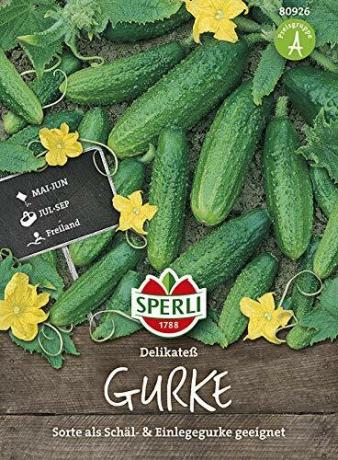
Sperli-Seeds Gherkin Delicacy
2,14€
Details →
pickled cucumbers
- foothill grapes: Very robust and fast-growing gherkin; high yields and aromatic taste.
- Excelsior (F1): Newly bred F1 hybrid; extremely productive; subtle spines on the cucumber fruits; crisp fruits with excellent taste; high quality.
- Corentine (F1): Forms only female flowers; very productive; outstanding aroma without bitter substances; good resistance to powdery mildew, mosaic virus and cucumber scab.
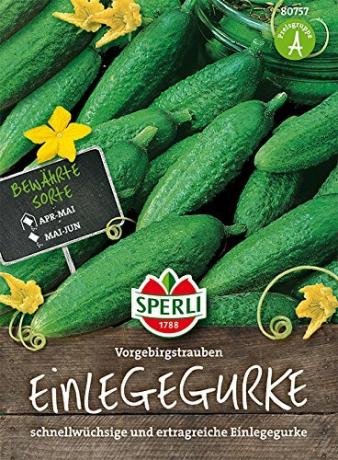
Pickled cucumbers, foothill grapes
3,99€
Details →

Sperli Pickling Cucumber Excelsior
6,98€
Details →

Gherkin 'Corentine'
Details →
peeled cucumbers
- Fate: Well-established cucumber variety with lush fruits (40-50 cm long; 8-12 cm thick); the harvest should better be peeled before consumption, as the peel is quite tough.
plant cucumbers
When growing cucumbers, there are basically two ways to grow the plants: Direct sowing or pre-cultivation in pots.
As no-till
In the case of direct sowing, sowing can only be started from mid-May, as planting should under no circumstances be done before the ice saints. With this form of sowing, the seed spot in the bed should be earthed up about 20 cm beforehand. The seeds are then sown 3 to 4 cm deep and 30 to 50 cm apart. A larger row spacing of 1 to 1.5 m should also be maintained, as cucumber plants can become very sprawling.
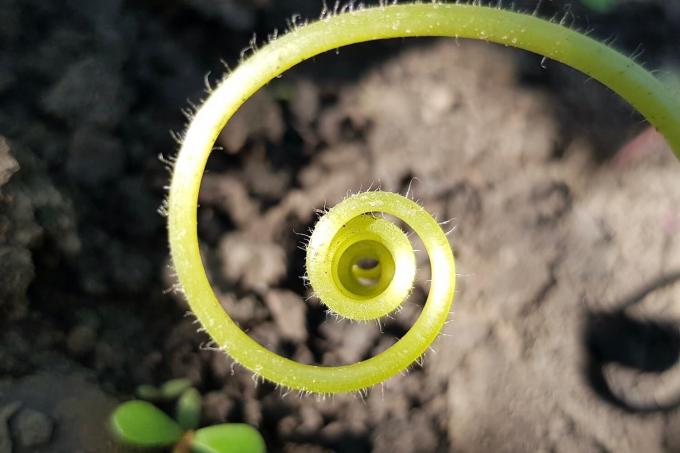
As a preculture
Pre-cultivation on the windowsill or in the cold frame is a sensible alternative, since the harvest can be expected earlier. In the case of the pre-culture, sowing should be done at the end of April at the earliest, because the young plants must not be too big when planted outdoors in May. For cultivation indoors, the pot is only half filled with soil and 2 to 3 seeds are planted approx. Sow 1 to 2 cm deep. At 20 °C the seeds germinate after a few days. As soon as the largest and strongest seedling is sticking out over the edge of the pot, the other seedlings are removed and the pot is filled up with soil so that the leaves are still sticking out. This technique is used to ensure that the young cucumber plant develops adventitious roots. These are roots that arise above the actual root on the shoot. These provide more stability and increase the absorption of nutrients.

When the ice saints are over, the early young plants can be planted in the bed as with direct sowing. Before finally planting, it is worth hardening off the young plants by initially placing them outside for several hours a day. In the bed, it is also advisable to protect the cucumber plants with fleece at the beginning. However, fleece protection should only be used in cold temperatures and not permanently, so that the air does not accumulate too much underneath. Some cucumber varieties also produce their fruit without pollination, but the fleece should be removed at the latest when the flowers form. A useful method of support at the beginning is to lay out black foil under the plant. Both materials help to keep the sensitive plants warm during late cold snaps.

These tips will help when planting cucumbers in open ground:
- Direct sowing from mid-May, pile up the soil 20 cm and sow 3-4 cm deep (distance 30-50 cm and row spacing 1-1.5 m).
- preculture from the end of April; 2 to 3 seeds in a half-full pot at 20 °C; when the strongest seedling grows over the edge, fill the pot with soil.
- Use fleece or black film to protect against the cold.
If these tips are followed when planting cucumbers, the young plants will have a good start for the summer.
Cucumber growing care
Cucumbers are usually very healthy. But to ensure that the cucumber plants stay healthy and have a high yield, there are a few care instructions to consider.
Water cucumbers properly
Cucumbers are mostly made up of water. It is therefore not surprising that their water requirements are also very high. The soil should always be kept nice and moist, and a layer of mulch around the plant also prevents excessive evaporation. Nevertheless, you should make sure that there is no waterlogging - cucumber plants don't like that at all.

To prevent fungal infections, water should not be poured over the leaves, but always directly into the soil. A note when watering is particularly important: The water should never be too cold! It is best to use only warm water from the rain barrel. The reason for this is that the cucumbers can become bitter later (also due to severe drought).
Fertilize cucumbers properly
In order to provide enough nutrients to start with, it is advisable to work compost into the soil before planting the cucumbers. A primarily organic organic fertilizer like ours is just as suitable Plantura organic tomato fertilizer with long-term effect. As a rule, cucumbers do not need to be fertilized much, as long as the location is chosen sensibly. The plant does not tolerate too much nitrogen well, so mineral fertilizers should be avoided. In addition, a load on the floor can be avoided.
When caring for cucumber cultivation, a few points should be observed so that the harvest is productive:
- water a lot
- Avoid waterlogging and do not wet leaves with water
- Only use preheated water (otherwise cucumbers can become bitter)
- Fertilize little
- Prepare soil with compost before planting
tip: Just like tomatoes you can too Pick cucumbers, which can help to counteract diseases.
Diseases and pests in cucumbers
Cucumber plants are not considered particularly demanding. Nevertheless, improper care can result in damage from diseases and pests. A common problem that is not caused by a fungus or animals is shedding of young fruit. This happens due to the excessive setting of fruits, which the plant cannot optimally supply itself. Here, removing a few fruit buds helps to leave enough energy for the existing fruit.
Another problem that occurs very often is caused by the infestation of Powdery and downy mildew. Powdery mildew can be recognized by a white coating on the leaves, downy mildew by golden-brown spots on the upper side and white coating on the underside. Angular leaf spot disease is also a relatively common disease. The bacterial infection can be recognized by angular and brown spots on the leaf. These tips will help to avoid such diseases on cucumber plants:
- Not too high humidity
- Do not wet leaves when watering
- Don't keep stock too tight
- Observe crop rotation
- No excessive nitrogen fertilization
- Select healthy and resistant varieties

Harvesting and storing cucumbers
Even before most types of vegetables are ripe, it is time to harvest cucumbers. The following tips range from the harvesting process to the ideal storage of the cucumbers.
Harvest cucumbers properly
Cucumbers are very fast-growing vegetables, so outdoors they can be harvested as early as July. It's even earlier in the greenhouse: it's even possible there from the end of May! Just two weeks after flowering, the healthy cucumbers can be used in the kitchen. The following applies: lettuce and pickling cucumbers are harvested while they are still unripe (deep green colour), peeled cucumbers can take a little longer to ripen. So that you don't miss the right harvest time, you should pay attention to these signs:
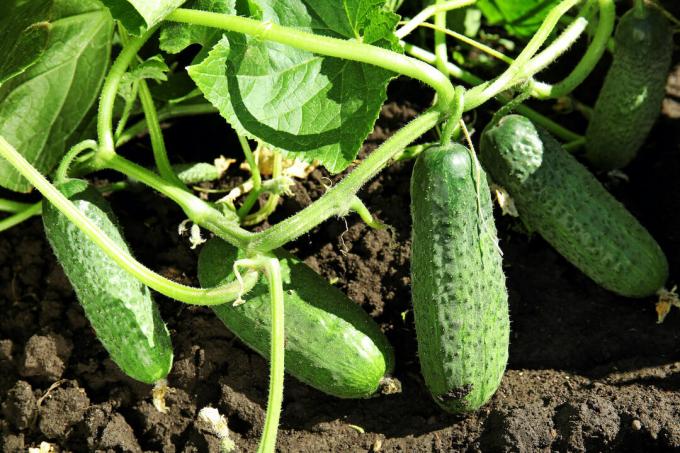
- Smooth shell
- Uniform green
- No yellow color (overripe)
To harvest the cucumbers, the fruit is cut off with a knife right at the stem. It should be harvested regularly to keep the plant producing fruit. In addition, you should cut off new blossoms from August - this way the plant has enough energy for the cucumbers that are already growing.
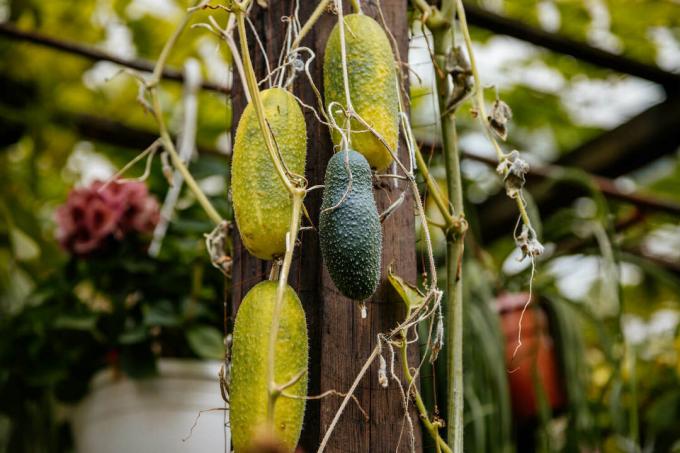
Store cucumbers properly
How and for how long cucumbers can be stored depends entirely on the variety. While cucumbers are best eaten fresh, pickles are typically canned in jars.
Cucumbers usually don't last long. The temperature is decisive for the storage time. Ideally, this is around 10 to 13 °C - so neither the refrigerator nor the room temperature are ideal. Cucumbers originally come from warmer regions, which is still evident when they are stored. Cucumbers should therefore only be stored in the refrigerator for a few days. Otherwise, they can become mushy and blotchy.

Since green vegetables are mostly made up of water, they definitely do not belong in the freezer! Direct storage with apples or tomatoes should also be avoided. The reason for this is the so-called ethylene, a gas that stimulates ripening. The gas is produced by the fruit and causes cucumbers to overripe quickly.
Pickle cucumbers
As the name suggests, pickles are perfect for storing in mason jars. As a result, cucumbers can be eaten for many months and throughout the winter. When canning, the cucumbers are usually pickled with vinegar, garlic, onions, dill, bay leaves and mustard seeds. The decisive factor for the shelf life is whether the cucumbers and the other ingredients have been heated beforehand. This is the only way to store healthy vegetables for longer. A detailed guide to Storage and pickling of cucumbers you'll find here.
For a particularly rich cucumber harvest, take a look at this article: We give you 10 tips for the best cucumbers from your own garden.



